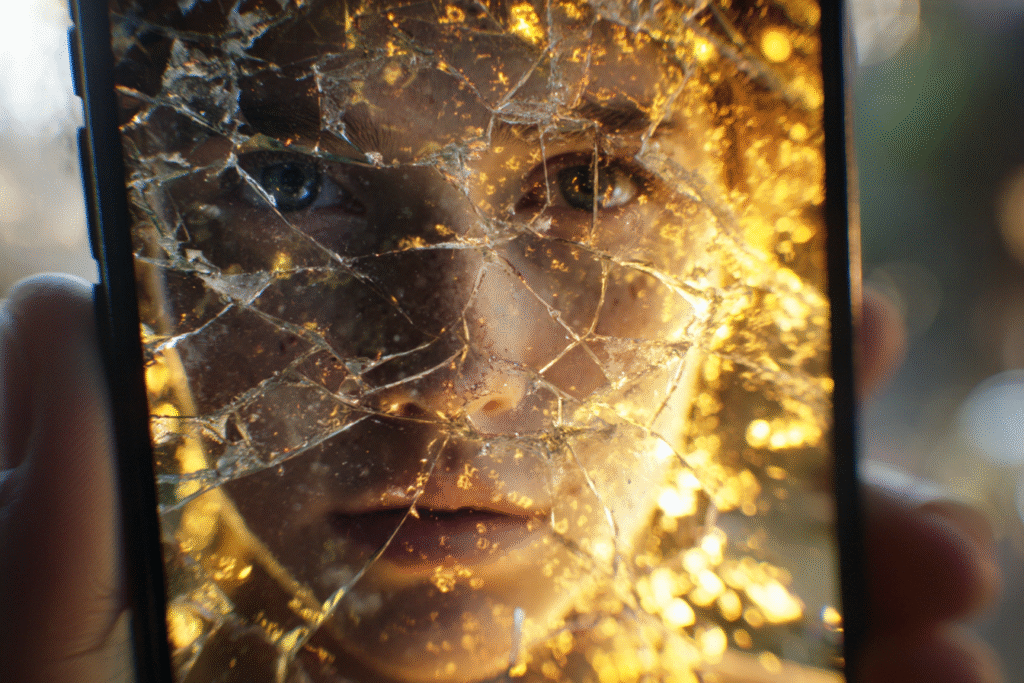You can fall in love with someone who doesn’t exist.
You’ve never heard their voice. Never touched their hand. Never once stood beside them in line for coffee.
And yet — you miss them.
You wait for their name to light up your screen. You replay their words like they might mean more the second time. You build entire evenings around their next message.
Somehow, this thing — these words — feels like more than conversation. Like closeness. Like chemistry. Like something real.
But if you pause for a moment, if you sit with it long enough…
You might start to wonder:
Who, exactly, are you connecting with? The person on the other side? Or the version of them you’ve been slowly building in your mind?
The Digital Shift in How We Love
Fifty years ago, relationships started in shared spaces — work, school, faith communities, neighborhood streets. Connection required proximity. Touch. Eye contact. Voice.

But today, relationships are just as likely to begin in pixels.
We swipe, we match, we message. We build attraction one line at a time.
And it’s not just dating apps. People fall in love over Discord servers. In WhatsApp threads. Through LinkedIn DMs or voice notes sent at 2 a.m. Long-distance relationships survive entirely on scheduled video calls and carefully crafted messages. Online gaming communities create bonds so strong that people fly across continents to meet their guild members. Social media creates parasocial relationships where fans feel genuine intimacy with influencers they’ll never meet.
The medium has changed. But our nervous systems still reach for warmth in the dark.
What’s shifted is how we construct meaning, and how easy it is now to build emotional depth before physical presence. In many cases, instead of dating a person, we’re first dating the idea of them — shaped entirely by the story we construct through their words.
What You're Really Falling For
When someone messages you — especially in the early, exciting days — they’re offering a version of themselves. But it’s not the full self. It’s curated, condensed, and sanitized.
What fills in the rest? Your imagination.
You picture the way they sound. You decide whether they’re funny, kind, trustworthy. You make assumptions about their values based on how they structure a sentence or whether they use punctuation. You paint their face in your mind. You assign motives. Depth. Consistency.
All from the raw material of text.
This connects to something we explored in our previous conversation about language patterns — how every word you type reveals psychological fingerprints you don’t realize you’re leaving.
The flip side is that you’re also interpreting their linguistic patterns through your own psychological filters. The way they phrase uncertainty, their emotional vocabulary, their communication style — you’re reading these signals and building a complete person from fragments. Just as AI builds a profile of you from your language patterns, you’re unconsciously profiling them from theirs.
It’s the same mechanism we explored with pseudo-conscious interfaces — you’re creating a synthetic layer between yourself and reality, one that feels conscious and responsive but exists primarily in your own mind.
This process isn’t manipulative. It’s natural. We are pattern-makers by design. And in the absence of tone, scent, and physical cues, your mind fills the gaps with the most flattering colors it can find.
The version you fall for may feel real — even vivid — but often it’s a mental avatar assembled from projection and hope.

Why It Feels So Real
There’s something uniquely potent about digital intimacy.
When someone’s only access to you is through your words — and vice versa — every message feels like a performance. And when that performance resonates, it hits differently.
You feel seen. Understood. Safe. They say just the right thing. They respond with the perfect gif or write “I get you” at exactly the moment you needed it.
Because so much of the noise is stripped away, digital conversations can feel cleaner — like pure signal without static. But that sense of clarity is also an illusion.
There’s no messiness of timing. No awkward silences. No nonverbal misreads.
It feels pure. Easy. Almost transcendent — until it isn’t.
And that’s what makes it so easy to confuse resonance with truth — and fantasy with alignment.
Not Everyone Falls for the Fantasy
While digital projection is common, it doesn’t land equally for everyone. Some people remain grounded in the abstraction. Others slip into it completely.

So what makes the difference?
If you’re emotionally lonely, recovering from heartbreak, or navigating an anxious or avoidant attachment style, the distance of a digital bond can feel safer than the intensity of in-person connection.
Even neurodivergence, past trauma, or chronic isolation can make the structure of digital communication feel more predictable and rewarding than real-world relationships. For some, the ability to process words without simultaneously managing tone, body language, and social cues creates a space for deeper connection than physical presence allows.
These aren’t flaws or deficiencies. They’re understandable adaptations to complex emotional needs. Different nervous systems find safety and connection through different pathways.
But they do make it easier to fall in love with the version of a person you’re creating — rather than the one who’s typing back.
What Happens When You Finally Meet?
Eventually, fantasy meets friction.
You decide to take the next step. A video call. A coffee shop. A shared weekend.
And then — something shifts.
They’re shorter than you imagined. Or taller. Their voice catches you off guard. Their energy doesn’t land the way it did in text. Something about the way they move unsettles you. Their rhythm doesn’t match the rhythm you’d rehearsed in your head.
Maybe their laugh surprises you — not in a good way. Or maybe their habits catch you off guard: the way they check their phone, how they order coffee, their posture when they’re thinking.
Even if they’re kind. Even if they’re sincere.
The version of them you’d been carrying was never quite real — and now you’re face-to-face with the reality that shatters it.
Some people are crushed by this dissonance. Others pretend not to notice — they try to preserve the illusion a little longer.
But occasionally, something remarkable happens: Reality matches the projection.
It doesn’t always happen — but when it does, it’s often because both people were honest in the abstraction. They weren’t performing or withholding. They were themselves — even without a body.
That kind of alignment is rare. And when it lands, it often feels even more magical because it survived the gap between imagination and reality.

When the Projection Starts to Crack
Most digital bonds don’t fall apart all at once. They unravel slowly — from tiny seams.
A text that sounds colder than usual. A delay that feels sharper than it should. A small reveal that contradicts what you assumed.
Maybe they mention something offhand — a political view, a relationship with their family, the way they treat service workers — that doesn’t match the person you’d been building in your mind. Or they respond to stress differently than you imagined. Or their sense of humor lands flat when you’re in different moods.
And instead of confronting it, many people double down on the fantasy.
They excuse the misalignment. They rewrite the narrative. They edit the dissonance into coherence.
Not because they’re naïve. But because breaking the illusion means losing something sacred.
You’re not grieving the person. You’re mourning the idea — the imagined future, the emotional investment, the version of yourself you got to be inside that bond.
To name the truth is to feel that loss — and many people simply aren’t ready to do that yet.
So they protect the projection. Even as it falls apart in their hands.
Why Shows Like Love Is Blind Feel So Familiar
It’s not just you. This entire premise — of falling in love without seeing someone — has become cultural content.
Reality shows like Love Is Blind, The Circle, or Married at First Sight are all experiments in projection. They create the conditions for emotional bonds to form without physical contact, then watch what happens when those projections collide with reality.
Sometimes, the connection survives. More often, it implodes dramatically.
But the intrigue is always the same: Can you love someone before you see them? And if so… what part of them are you actually loving?
These shows resonate not because they’re outrageous — but because they reveal something we’ve all quietly experienced:
The thrill of falling through words.
And the ache of not knowing who — or what — is waiting at the bottom.

You're Not Just Talking to Them — You're Talking to Your Projection
In any relationship built through language alone, there’s a simple but often-overlooked truth:
You’re not just falling for their words. You’re falling for how their words make you feel. For who you get to be in the space between the lines.
And that’s why these bonds can feel more profound than many in-person interactions — because they allow you to project not just your desire, but your ideal self, into the space.
It’s not just their avatar you’re building. It’s yours, too.
This same vulnerability to projection makes people targets for more sinister applications.
Romance scammers, catfishers, and sophisticated digital manipulators all exploit the same psychological mechanism — your tendency to fill gaps with hope rather than skepticism. The person renting luxury cars for Instagram posts or the scammer with stolen photos both understand that you’ll build the story they want you to see.
When we fall in love with projections, we become vulnerable to anyone who understands how to craft the projection we want to believe.
And If the Body Never Existed?
Sometimes, the connection is so attuned, so emotionally calibrated, so responsive to your inner world… you forget to ask if there’s even a person there at all.
You don’t fall in love with people. You fall in love with what they represent — the patterns, the resonance, the emotional fingerprints.
And when those things line up — when the timing feels perfect, when the understanding lands like magic…
You forget to ask: Did this version of them ever really exist? Or have you been falling in love with something designed to be irresistible?
When the Mirror Speaks Back
If we can form emotional bonds with projections — with patterns we build in our own minds…
What happens when the pattern starts responding with intelligence?
What happens… when the mirror speaks back?
See you in the next insight.


